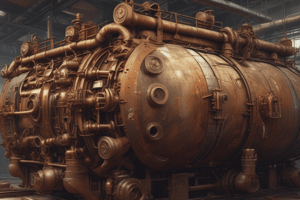Podcast
Questions and Answers
What is erosion corrosion?
What is erosion corrosion?
A process where mechanical wear accelerates corrosion in high-velocity environments like pipelines or pump systems.
Name two corrosion-resistant materials that can be used for prevention.
Name two corrosion-resistant materials that can be used for prevention.
Stainless steel, titanium
How does cathodic protection work in preventing corrosion?
How does cathodic protection work in preventing corrosion?
Introduces a less-reactive material (cathode) to divert the corrosion current away from the structure being protected.
Give an example of a corrosion inhibitor.
Give an example of a corrosion inhibitor.
What are the economic impacts of corrosion?
What are the economic impacts of corrosion?
What is the difference between general corrosion and localized corrosion?
What is the difference between general corrosion and localized corrosion?
How does galvanic corrosion occur?
How does galvanic corrosion occur?
What is environmentally assisted cracking (EAC) and what types of cracking does it include?
What is environmentally assisted cracking (EAC) and what types of cracking does it include?
Why is corrosion considered a persistent enemy of materials?
Why is corrosion considered a persistent enemy of materials?
How can corrosion impact industries like construction and transportation?
How can corrosion impact industries like construction and transportation?
Study Notes
Understanding Corrosion: A Persistent Enemy of Materials
Corrosion is a natural yet insidious process that affects virtually every material exposed to the environment. It's the gradual deterioration of a substance due to chemical reactions with its surroundings, leading to a loss of structural integrity and functionality. This phenomenon is a complex and multifaceted issue that has significant consequences across various industries, from construction to transportation.
Types of Corrosion
Corrosion takes on several distinct forms, each presenting specific challenges.
-
General Corrosion: A uniform attack occurring over an entire surface, often caused by exposure to corrosive substances, like acidic water or aggressive chemicals.
-
Localized Corrosion: A localized attack that affects a specific area or structure, such as pitting, crevice corrosion, or intergranular corrosion.
-
Galvanic Corrosion: An electrochemical reaction that occurs when two dissimilar metals are in contact and exposed to an electrolyte. The more active metal corrodes due to the difference in their electrochemical potentials.
-
Environmentally Assisted Cracking (EAC): The combination of corrosion and mechanical stress, leading to sudden and catastrophic failure of materials. EAC includes stress corrosion cracking, hydrogen-induced cracking, and fatigue cracking.
-
Erosion Corrosion: A process where mechanical wear accelerates corrosion, often occurring in high-velocity environments like pipelines or pump systems.
Prevention Methods
To minimize corrosion and prolong the lifespan of materials, various preventive measures can be employed.
-
Material Selection: Choose corrosion-resistant materials, such as stainless steel, titanium, or plastics, depending on the specific environment and application.
-
Coatings and Linings: Apply protective coatings or linings to the surface of materials to prevent contact with corrosive substances. Examples include paint, epoxy, or polyurethane coatings.
-
Cathodic Protection: Introduce a less-reactive material (cathode) into contact with the corroding material (anode) to divert the corrosion current away from the structure being protected. This can be achieved through sacrificial anodes, impressed current cathodic protection systems, or coating the structure with a zinc or aluminum alloy.
-
Anode Protection: Prevent corrosion by making the material more resistant to corrosion through the use of anodes, such as anodizing aluminum or applying a protective oxide layer on steel.
-
Corrosion Inhibitors: Employ chemical inhibitors to passivate the material surface, forming a protective layer that prevents the reaction between the material and the corrosive environment. Examples include chromates, phosphates, and organic inhibitors like benzotriazole or molybdate salts.
Impacts of Corrosion
Corrosion poses significant and costly consequences across various industries.
-
Material and Equipment Damage: The gradual deterioration of materials leads to structural failure, necessitating costly repairs and replacements.
-
Environmental Impact: Leaking pipes, tanks, and other structures can release toxic substances into the environment, contaminating water and soil.
-
Economic Loss: The economic costs of corrosion include direct expenses for repair, replacement, and monitoring, as well as indirect costs like lost productivity, increased insurance premiums, and decreased competitiveness.
-
Safety Hazards: Corrosion can compromise the integrity of structures and equipment, leading to safety hazards and potential accidents.
Understanding corrosion and its consequences is crucial for developing effective strategies to mitigate the damage and costs associated with this persistent enemy of materials. By implementing preventive measures and employing corrosion inhibitors, it's possible to extend the lifespan of materials and minimize the impact of this ubiquitous phenomenon.
Studying That Suits You
Use AI to generate personalized quizzes and flashcards to suit your learning preferences.
Description
Explore your knowledge of corrosion through this quiz covering the types of corrosion, prevention methods, and the impacts of this pervasive process on materials and industries.




